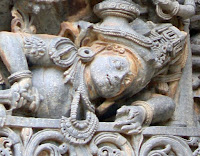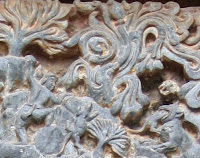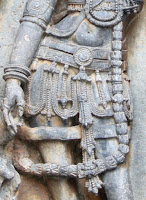The imagination, skill, planning and execution are exemplary, parts of which I would like to highlight in this article. The ability to chalk out the idea of all the parts to be carved from this single stone, preserving it, while also removing pieces from nooks and corners behind all the hands, legs, fingers, objects held, etc., is amazing.
One of the first things we can notice is that the fierceness depicted in the face of Ugra Narasimha. Though the crown of Narasimha does not seem to be as well polished, it could be the deterioration due to exposure to nature - winds and rains.To carve out the killing of Hiranyakashipu, as per the story, involves showing the ripping of the stomach and removal of intestines. Here, some of the intestines are shown just lying on the stomach and Narasimha disembowels the demon king. Also some of the intestine has been pulled up and worn like a victory garland, in the imagination of the sculptor.One can also observe that one of the paws of Narasimha has dug deep into the leg of Hiranyakashipu, with the claws deep inside the skin, hidden away, while the rings on the fingers are nicely in place. Ornamentation on the dress of Hiranyakashipu is portrayed well too.The mini sculptures on both sides of the scene are intricately worked too. Here is an illustration of Garuda, the vahana of Vishnu, paying obeisance to Narasimha, clearly indicated by the wings and the long nose.In order to represent Hiranyakashipu as a demon, the canine teeth are shown protruding. He holds a sword in the right hand, which is firmly restrained by one of the hands of Narasimha. In the other hand he holds a shield, but lying in an awkward position as he is incapacitated, lying on the lap of Narasimha. The intricacy and attention to detail is seen in the pieces of rock behind the hands and the crown having been perfectly removed to give a realistic and proportional 3-dimensional work of art.One of the challenges in the portrayal of the Hindu Gods and Goddesses, is to carve the many hands, legs, ornaments, weapons, tools, and other objects. Here is the superb work done on the right hand side arms and the weapons, though looking complex, faultless finger positions and ideal looking illustration of the hands.
The details on the conch, bell, clapper, etc., on the left hands, are even more stunning.
Finally we can look at the consummate form of a courtier of Hiranyakashipu attempting to help / defend against Narasimha, below the legs. Here the two legs highlighted in this portion of the photo show the ideal position of Narasimha's right foot resting on the floor, and Hiranyakashipu's left foot hanging, with intricate work on the toes, anklets, etc.To get a real feel of being in Belur, you can view a stereogram (pair of photos giving 3-dimensional view) of this sculpture that I have uploaded to Wikimedia commons. A high resolution single picture can also be seen in their repository. The carvings at Halebidu are not that well maintained, especially the damaged portions of the garland of intestines, which are mostly missing.
Art lovers should definitely visit such places at leisure, to not only take in the details, but appreciate the skills and abilities of the people of this land. The real sculpture beholden with our own eyes is priceless.


















































